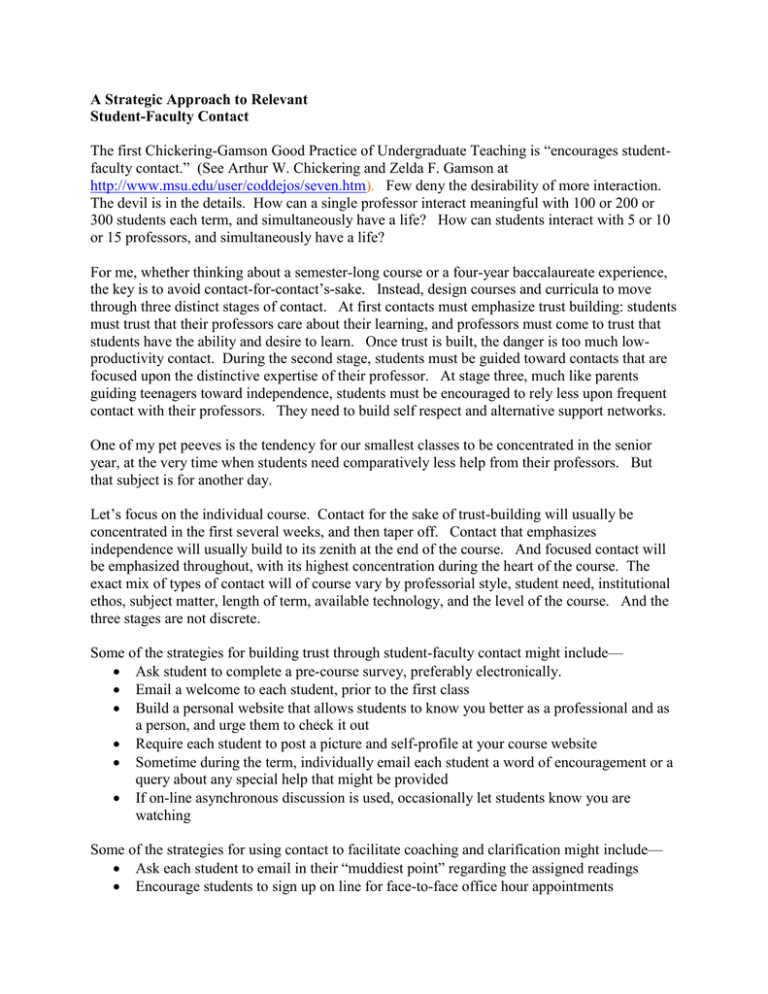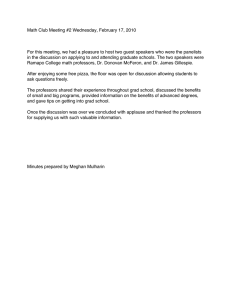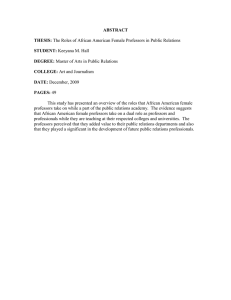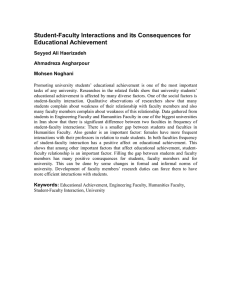A Strategic Approach to Relevant Student-Faculty Contact
advertisement

A Strategic Approach to Relevant Student-Faculty Contact The first Chickering-Gamson Good Practice of Undergraduate Teaching is “encourages studentfaculty contact.” (See Arthur W. Chickering and Zelda F. Gamson at http://www.msu.edu/user/coddejos/seven.htm). Few deny the desirability of more interaction. The devil is in the details. How can a single professor interact meaningful with 100 or 200 or 300 students each term, and simultaneously have a life? How can students interact with 5 or 10 or 15 professors, and simultaneously have a life? For me, whether thinking about a semester-long course or a four-year baccalaureate experience, the key is to avoid contact-for-contact’s-sake. Instead, design courses and curricula to move through three distinct stages of contact. At first contacts must emphasize trust building: students must trust that their professors care about their learning, and professors must come to trust that students have the ability and desire to learn. Once trust is built, the danger is too much lowproductivity contact. During the second stage, students must be guided toward contacts that are focused upon the distinctive expertise of their professor. At stage three, much like parents guiding teenagers toward independence, students must be encouraged to rely less upon frequent contact with their professors. They need to build self respect and alternative support networks. One of my pet peeves is the tendency for our smallest classes to be concentrated in the senior year, at the very time when students need comparatively less help from their professors. But that subject is for another day. Let’s focus on the individual course. Contact for the sake of trust-building will usually be concentrated in the first several weeks, and then taper off. Contact that emphasizes independence will usually build to its zenith at the end of the course. And focused contact will be emphasized throughout, with its highest concentration during the heart of the course. The exact mix of types of contact will of course vary by professorial style, student need, institutional ethos, subject matter, length of term, available technology, and the level of the course. And the three stages are not discrete. Some of the strategies for building trust through student-faculty contact might include— Ask student to complete a pre-course survey, preferably electronically. Email a welcome to each student, prior to the first class Build a personal website that allows students to know you better as a professional and as a person, and urge them to check it out Require each student to post a picture and self-profile at your course website Sometime during the term, individually email each student a word of encouragement or a query about any special help that might be provided If on-line asynchronous discussion is used, occasionally let students know you are watching Some of the strategies for using contact to facilitate coaching and clarification might include— Ask each student to email in their “muddiest point” regarding the assigned readings Encourage students to sign up on line for face-to-face office hour appointments During face-to-face office hours, simultaneously conduct chat room office hours. Create a frequently asked questions file for the course Provide access to the electronic course site from a previous semester Around class time, arrive early and linger after class Around exam times, hold an outside-of-class-time review session To promote and encourage “mature contact” -- Inform the students when you are transitioning toward more independence Encourage students to check with each other before consulting you Encourage former students to volunteer as consultants to current class members Create a frequently asked questions database, with answers Continue communicating through listserv or group email with members of a class, even after the term is over Email former students about local professional meetings and special campus events, and invite them to participate with you Create a departmental website about career opportunities in the field, and urge students to consult it ---Contact for the sake of trust. ---Contact for the sake of coaching and clarification. ---Contacts characteristic of a mature partnership. Technology enhances possibilities in all three domains. Please go to the Syllabus Forum website (http://syllabus.com/forum/display_forum_topics.asp?ForumID=6) under “Faculty Practices— Enhancing Student-Faculty Contact” to share your useful practices with others and to read what others are sharing on this topic.


